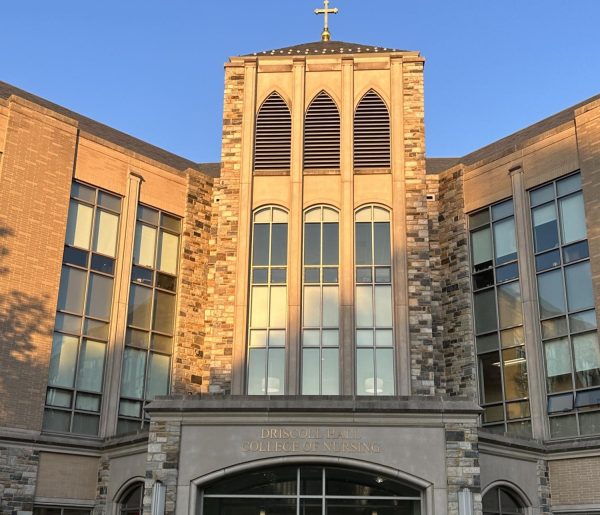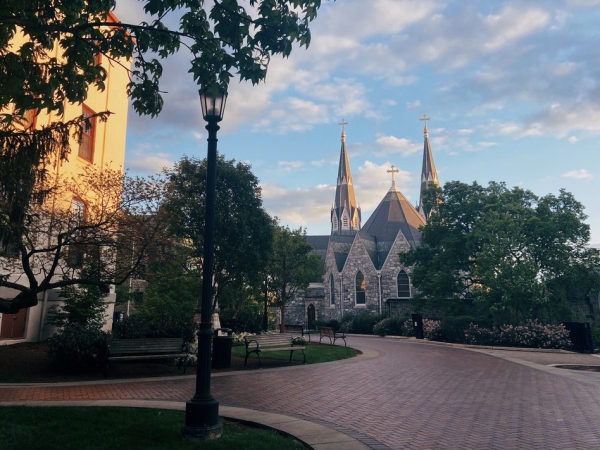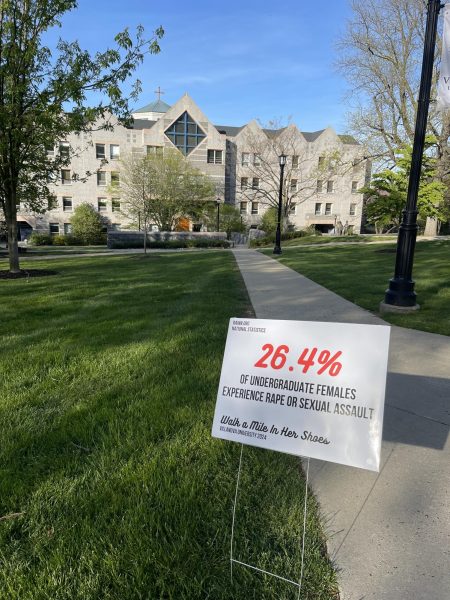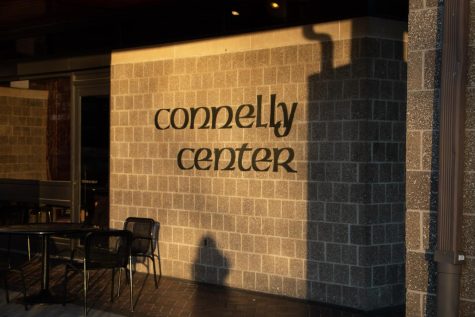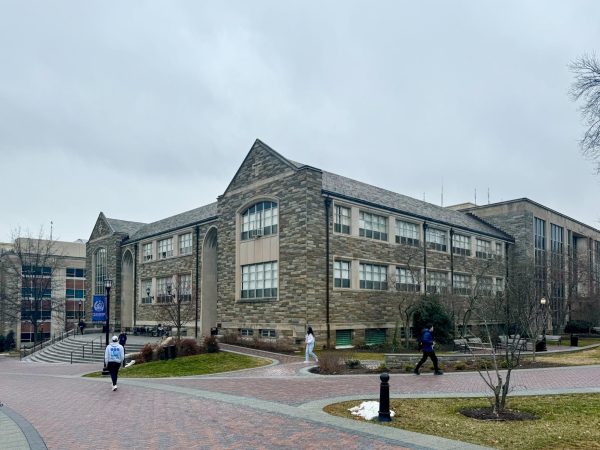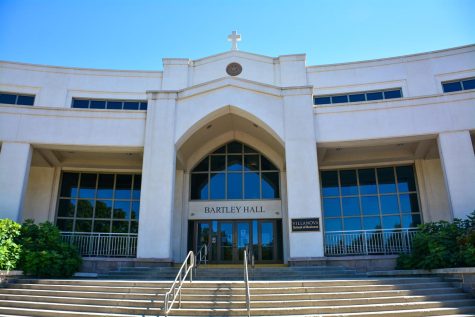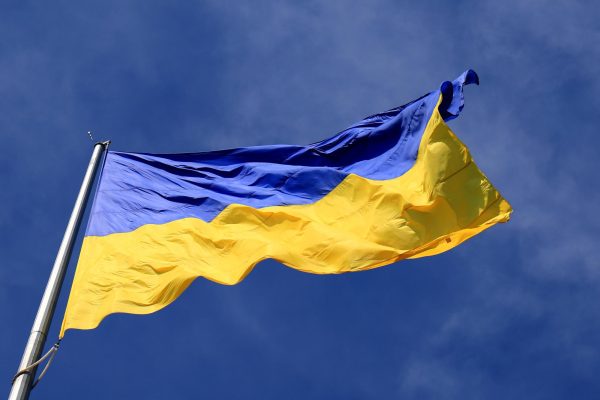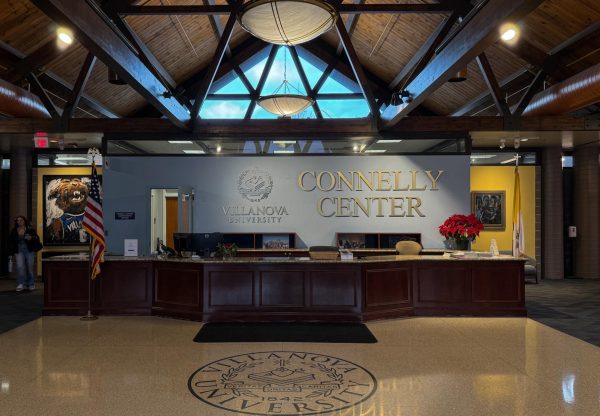Race on Campus
October 26, 2016
Princess Garrett contributed the content that made this article possible.
I’m waiting in line at Holy Grounds in Connelly Center mulling over my usual favorites—tall black iced tea or grande black hot tea. I need the caffeine kick before I head to Dougherty 201 for newspaper production. I’m scrolling through my Twitter feed on my phone, and there’s a student behind me talking on the phone. I overhear him: “Yeah man, I’ll be there in five minutes. I’ve got this Chink in front of me.”
***
It’s the fall of 2014, and a sophomore is on her way to work in Connelly when she spots a Black Lives Matter protest at the Oreo. She waves to a familiar face in the group of protesters wearing black and holding up signs. Her acquaintance says, “You know, if you really cared, you wouldn’t go to class.”
***
A junior nursing student and her older brother are in a car together approaching West Campus. The guard at the gate refuses to let the car in, insisting the driver, the junior’s brother, is an Uber driver, despite the junior stating he is family. The two were born in Pakistan. This is the third instance a guard has refused to let the junior’s family member drive her to her dorm.
***
Homecoming 2016 festivities on campus commence as a Black Lives Matter protester holds up a sign reading, “Do Black Lives Matter Only During Basketball Season?”
***
Between August and October, The Villanovan interviewed 16 students: seven white students, five black students, three Asian students and one Latino student. Our objectives were to report on the state of race relations on campus, to interview students with diverse beliefs and opinions, to expose acts of racism and microaggression on campus and to assess the University’s efforts to create racial harmony. According to the Institute of Education Sciences Center for Education Statistics, a national organization, Fall 2015 enrollment at the University was 74 percent white. How does this figure affect the students in and out of the classroom?
Racial Self-Awareness on Campus
Eight out of nine students of color expressed they have been very aware of their race on campus.
When an Asian American senior discovers she’s the only person of color in her class, she feels a sense of dread and an unwanted commitment to be the voice of the minority for the class. She views this responsibility an expectation of her peers. “I can honestly say that every Asian person I know here—we can honestly saw we considered transferring after our first year,” she says. “I decided not to transfer, because how incredible is it that I get to be on campus and watch this transform into a place of inclusion with a voice for all?”
Sophomore Ayan Goren is a black female Muslim student who wears an hijab. Given the pervasiveness of Islamophobia, Goren recognizes her headscarf as a possible source of discomfort. Though she considers herself naturally bubbly, polite and smiley, she feels she must accentuate these aspects of her personality to compensate for her religion, hijab and blackness and the perceived “threat” they all carry. She is no different from her peers, but she wears a headscarf so she is consequently viewed differently.
Mitsy Wedderburn ‘18 and another senior have their hair touched without permission.
Many note a theme of niceness in the University’s dominant culture focused on politeness, smiles and small talk. Senior Kinjal Dave’s racial self-awareness peaked when she arrived at the University and was confronted with a different way of communicating. “There was something overwhelming about the culture of niceness and sort of making small talk that you didn’t feel like people were talking about real issues or what was really on their mind,” Dave explains. “Villanova is a Bachelors in ‘How to Talk to White People.’ White students don’t have to learn how Asian Americans interact.”
Ecuadorian American, Michael Medina, ‘18 leaves his apartment on West and looks around, realizing hardly anyone looks like him.
***
Three white students expressed little to no awareness of their race on campus.
Senior Eric Aldieri’s awareness has grown in his four years. “Being white,” he says, “you’re not called attention to your race on an everyday basis. . . it’s not something that I’m forced to see, but I try to be aware of.” However, other students view this alertness as a drawback. A senior English major is hyper aware of her whiteness and sometimes, she believes, to her own detriment. “It hinders the way I interact with other people,” she says. “‘Whiteness’ equals ‘privilege’ for a lot of students, and even if I were to broaden my experiences, travel or meet new people, I still feel like I would be ‘white.‘” A sophomore feels uncomfortable when his race is pointed out by others. “It’s the same way a black person would be uncomfortable if they were called black,” he says. He associates white privilege with reverse racism and believes “minority groups tend to discount white people’s successes based on the color of their skin.” A senior engineer fears sharing many of his opinions. “I think my credibility is automatically undermined, because I’m just a ‘regular white guy,’” he says. “Everyone has struggles, but I can’t talk about my problems, because God forbid, that doesn’t even compare to what people of color deal with.” This sentiment is shared among a number of white students on campus who feel recent race-related rhetoric hinders them from voicing their own opinions or talking about conflicts they face.
Black Lives Matter Movements
The University has witnessed a few protests on campus along with the occasional “Black Lives Matter” posters in dorm halls. Just last week, during Homecoming Weekend, the University saw a Black Lives Matter protest at the Oreo. The group of concerned students and faculty constructed an email to Rev. Peter M. Donohue, Ph.D, O.S.A, multiple deans and the Chief Diversity Officer, Terry Nance, Ph.D. The email’s authors claimed the University’s idleness in the movement endangered the community and sent a list of demands to ensure “Black Lives Matter on our campus.” Throughout the demonstration at the Oreo, the participants shared names of people killed by police, chanted “Black Lives Matter” and scheduled “die-ins” in which students and faculty lie down on the ground, while one volunteer stands holding a sign reading “Am I still a threat?” One tour guide quickly led his group past the protest ensuring his group that “this type of thing” was rare on campus. “Don’t worry,” he said. As another tour guide approached the scene, she said, “So here is a Black Lives Matter protest. I’m not going to shout over them, so we will respectfully pass in silence.” These responses represent two unique perspectives of Black Lives Matter protests. For some Ambassadors and Blue Key Members, the protest might shock prospective students. For others, the event demonstrated the University’s acceptance of campus protests.
Given the undergraduate white population is 74 percent white, Keanine Griggs ‘18 doesn’t expect many students to participate in Black Lives Matter protests on campus. “[The protests are] not going to be the size of a Howard University BLM protest or a Rutgers one,” he says. However he joins the protests when he can and is comforted by those who participate. “I can understand if you’re raised to respect the police force, and you’re going to find it weird that people are protesting the police,” he admits. “But, advocating for black lives doesn’t mean you’re against all lives or white lives or police lives. It’s just saying, hey, we matter too!”
A junior claimed a double standard exists with protests on campus and in America. She recalls watching hundreds of predominately white students rioting, lighting furniture on fire and climbing poles after the men’s basketball team won the NCAA final game. “We were all just standing there on a ledge on Sullivan watching and thinking what if the entire black population—which isn’t much—did the same?” she asked. “What would people think?”
A sophomore believes the movement misconstrues information about race and crime in America. He asserts white people also want to combat racism and crime, but Black Lives Matter protests only serve to propagate division between races. “The BLM movement source isn’t racism, it’s anti-white,” he says. “We want to help fight [racism], and in order to do that, we need the blacks to give us certain policies and help us fight it and grow their community.”
With regard to previous years’ Black Lives Matter protests, a senior engineer major felt more willing to quickly and nervously walk by the demonstration while on his phone than to spark a conversation with the participants. “People standing and yelling in front of the Oreo felt a little hostile,” he says. “I respect their decision to protest, [but] it wasn’t an environment where I felt safe or comfortable to walk up to someone to learn something new.”
Campus Dialogue
It’s clear there’s much discussion on campus about racial experiences and racial rhetoric. However, not everyone, regardless of race, feels comfortable talking about race. Students of color and white students express anger, frustration and confusion. Junior Medina suggests “safe spaces” offer a unique place where people can express their dissatisfaction and questions without risking judgment. “A safe space for me is a place where anyone and everyone can express their opinion regardless of ignorance, and or lack of ignorance and be heard,” he explains.
A senior English major, on the other hand, doesn’t feel safe spaces are truly safe for her. She felt a great deal of pressure to think more carefully about what she voiced to the group, worrying an authority figure or a group of students would criticize her opinion or views. Additionally, she watched a facilitating professor shoot down the idea of another student in a safe space last year. “That forum was a soapbox for the professor’s agenda where they only pointed to students they recognized,” she says. “I knew the student who raised his hand didn’t feel it was a safe space for him, because he told me after the event.”
Students tend to conflate safe spaces with “political correctness” —often in a negative or cautious perspective. A sophomore believes both compromise first amendment rights “to protect a minority group.” A senior economics major and Sean Carney ‘17 explained their struggle to keep up with the most current and socially acceptable terms. In middle school, the economics major called black students “African American,” but he recently learned there is a difference between “black” and “African American.” A number of people believe “African American” is a more favorable term for “black,” however African American refers to direct decency from American slaves, while black refers to race. So, someone from the Caribbean or Botswana can be black —not African American.
In recognizing students’ discomfort with accidentally saying something offensive or “not politically correct,” Medina offers a solution: PLEMI. PLEMI translates to “Please excuse my ignorance.” “If you say, ‘PLEMI,’” he explains, “I will answer any question you have, because it demonstrates you have good intentions and you are willing to learn.” Some believe PLEMI almost offers a pass on the need to be politically correct and calls for honest and judgement-free conversation. Aldieri desires to eliminate the word, “political correctness,” from political discourse, claiming it can be harmful in a productive dialogue. “It doesn’t do anyone any favors if you simply change your language to be politically correct than to go about doing the same business, participating in the same racist structures, so a lot of people interested in social change would rather you be politically incorrect if it meant you learning something in the end.”
Turning to the University
The University is committed to taking steps to improve diversity and inclusivity on campus with regard to the student body, faculty and staff. In June 2016, the Division of Student Life and the Office of the Provost announced the creation of the Center for Access Success and Achievement and the Office of Intercultural Affairs. The Office of Diversity and Inclusion was also created in the last year. CASA offers tutoring, retention and other services previously undertaken by the Center for Multicultural Affairs. OIA works to sustain a community of respect and inclusion for students “with a special focus on underrepresented students.” ODI, under the leadership of Dr. Nance and Brighid Dwyer, Ph.D. work to foster diversity and promote inclusivity on campus. Prior to her promotion, Dr. Nance worked with Student Life. Now, she works to achieve more diversity on campus on an institutional level.
During my discussion with Dr. Nance, I referenced a couple of racially charged incidents that happened on campus, including my own experience, and I asked, “How can the institution combat this?”
“What you experienced is a violation of community,” Dr. Nance says. “I feel like we have a greater promise to you at a Catholic institution.”
If students experience a major offense, the University is systematically set to deal with infractions. Dr. Nance explains another one of the current systems available for students, faculty and staff: Ethicspoint, a place where people report any injustice. “Let’s say you have a teacher you think is using racist, sexist, homophobic language, and you’re worried about your grade but you really want it to stop,” she illustrates, “You can use Ethicspoint to report it.” Looking to the future, she hopes to create a “biased response team” to further address these issues on campus.
“When I first took over,” she recalls, “we had much less student diversity than we have now, and I’m not satisfied yet.”
In the past year, Rev. Peter M. Donohue, O.S.A., Ph.D announced the appointment of J. Leon Washington as the Dean of Enrollment Management. Washington oversees the Office of University Admission, Financial Assistance, University Outreach and the Registrar while monitoring student enrollment, retention, meric scholarships and financial aid trends. In an email to The Villanovan, he explains the importance of diversity to the growth of a campus community. “Diversity enriches the educational experience and enhances the social development of students,” he says. “Diversity promotes creative thinking, in that it helps the learner view issues or problems from multiple perspectives, angles and vantage points.” He notes the numerous ways in which the Office of Admissions puts in effort to diversify campus. Dean Washington discusses the offices’ national and international admission staff, “purchasing multicultural search names to build a strong pool of diverse prospects who become applicants,” communicating with community-based organizations in targeting recruitment areas, offering opportunities for groups to visit the University and engaging alumni in targeted areas.
According to the Institute of Education Sciences Center for Education Statistics, Fall 2015 enrollment at the University was 74 percent white, eight percent were Hispanic or Latino, seven percent were Asian, and five percent were Black or African American. “While there is still a lot of work to be done,” Washington says, “We have been quite successful in the last few years by consistently enrolling classes where diverse students represented more than 20 percent of the class.”
Dr. Nance praises Admissions for reaching out to CMA when seeking to increase diversity on campus. “I consider Michael Gaynor an absolute genius for what he does,” she says. “When we began to see increases in outreach and the people who now know about Villanova that didn’t know about it before, that’s an example of taking a system problem and approaching it systematically.”
***
We attend a Catholic university on the Main Line where undergraduate tuition is around $48,000 a year. The religious, geographic and economic placement of a private institution naturally attracts a certain demographic of people—which is beyond the grasps of Admissions. “Where Villanova is located and the price of tuition—that’s all bigger than Villanova,” Carney says. Goren believes Catholic universities naturally attract white students, and says, “That’s a hurdle we won’t overcome as long as this is a Catholic institution, but I think there’s a need for more diversity, and I think we’re on the right path.” The university truly is making strides to improve outreach, retention and diversity. “Being a minority at Villanova is what you make of it,” Goren explains. “You have to seek out the right people. You have to make more of an effort to fit in and be comfortable, but it’s not impossible. I criticize Villanova to death, because I love it here. I love this institution, and I’m very happy with my decision to come here, but there needs to be change.”
***
Goren’s comments particularly resonate with me. I’ve experienced being called “chink” from a car going 50 miles per hour on Lancaster Ave. My Asian friend’s professor asked her how to make rice. Goren has felt tokenized in the classroom. My freshman orientation counselor experienced the n-word yelled at him on Lancaster Ave. But at the end of the day, I’m still more than willing to vouch for and support Villanova. Despite the microaggressions my peers and I have experienced, I still do not regret my decision to apply to the University. And I struggle with my own seeming hypocrisy. How can I defend a university where some students of color feel alienated? I also struggle with the idea that some white students feel silenced or uncomfortable when joining a conversation about race on campus. While it was difficult for myself to feel comfortable on this campus, and I still relapse into discomfort occasionally, I value the avenues of communication and academia the University has provided for me to be able to critically explore these issues. I realize not all students of color will agree with me, and perhaps that’s one of the biggest takeaways from this experience for me: There is no universal experience for students of color on campus. And Villanova must continue to further improve diversity and inclusivity.



